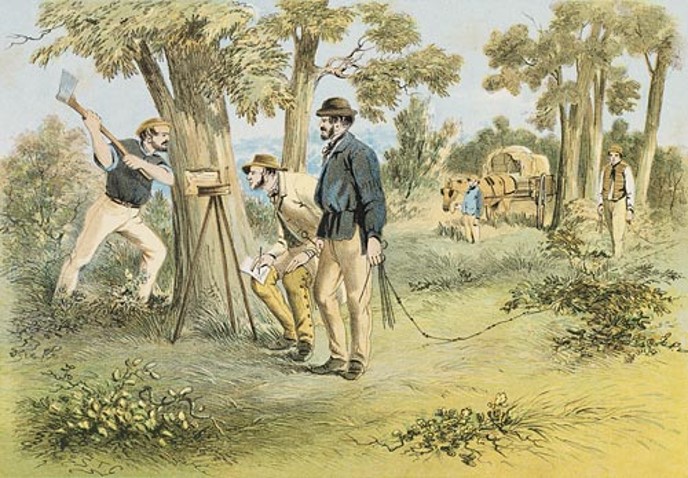

It’s pretty easy to take technology for granted these days.
Perhaps because it’s everywhere – at home with robotic sweepers and high-tech TVs; at work with smartphones and smart watches; and across the timberland investment industry.
But there was a time when life and timberland management were pretty low-tech. For the U.S., that time harkens all the way back to Colonial times when America was first being settled.
And while we tip our hat to the ingenuity and dedication of our early Colonial-era surveyors, there’s no denying that their methodologies have unknowingly created at least a few conundrums for today’s timberland asset class.
Here we’ve compiled 4 curious facts (including a few of those aforementioned head-scratchers) about land surveying, land records, tracts of land, correct acreage, and, more importantly, its importance when buying or selling timberland.
1. Surveying technology became an imperative with the colonization of America.
American surveying rose in prominence because it gave promise to leaving feudalism behind for the assurance of available land ownership. Accurate surveying (then and now) prevents chaos by establishing proper and accurate boundaries. The rub is in determining whether or not the boundary is accurate. So keep reading.
2. Early surveyors derived their base unit of measurement from an agrarian culture.
Land was quantified by a “day work,” which was the equivalent of the amount of land that a single individual could work in a single day. There’s a whole bunch of other calculations, ranging from base 4 to base 10 to decimalization, and perches, poles, and acres. Suffice it to say, it always comes down to mathematics. Enough said.
3. The Surveyor’s Chain
Until Edmund Gunter’s chain became the de facto one with the Land Ordinance of 1785, there was Vincent Wing’s chain; and it used an entirely different calculation and link structure.
“Wing’s Chain may have had a greater impact on the Colonies than we realize,” says Timothy S. Guisewhite, PLS, who recently shared the history of measurement with our GIS team. “It may be hidden behind the deeds in Virginia, West Virginia, North Carolina, and Tennessee what was merely written to the nearest ‘pole.’”
In other words, parts of the colonial settlements were measured with Wing’s chain, while the rest were surveyed with Gunter’s chain. Later during the western settlements, Gunter’s chain prevailed as a continued tool for laying out the Public Land Survey System (PLSS) system.
4. Up until the mid-1980s, the standard of land measurement was the surveyor’s chain.
The nature of the two-person chainmen measurement system – which involved walking, marking, tallying, counting, and repeating – was fraught with potential error, including miscounting, rounding, slope distances, and more, including chain wear and tear. Again. Error compounding upon error. This type of methodology stayed in place for nearly 300 years from the 1600s all the way up to the early 1900s.
Fascinating facts, for sure, but what does his mean for you, the timberland investor? Plenty!
“Remnants of chained measurements will always remain hidden in our land records,” says Guisewhite. In fact, he claims there’s a potential mess buried within our land records.
So, it goes without saying that such a mess could affect your next sale or purchase.
Sure, modern retracement methodologies on the ground and in the air, including those that leverage technology can measure large and complex areas quickly.
But if you don’t better understand history or neglect to analyze the data, then by only relying on a survey done 40, 50, or even 100 years ago, you could unknowingly be putting your asset at risk.
So, what do you think? Were you surprised? How confident are you in Colonial-era surveying as the basis for land investment due diligence? Will it change the way you look at your next sale or purchase?
Let us know in the comments.
P.S. Come back for the rest of this five-part series to learn more about the history of surveying and its implications on timberland investment assets. We should note that Tim’s extensive research and passion for early surveying helped fuel our advocation on the topic in the industry. Thanks, Tim.

Let’s Work Together
Orbis helps you make better sense of your assets, and better use of everything involved in managing them. Request more information or book a consultation with us today.